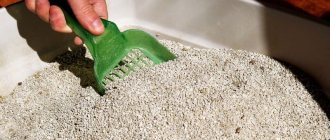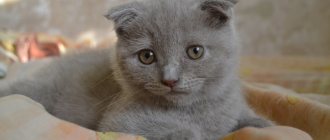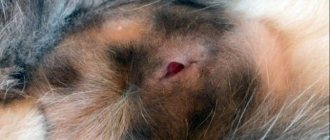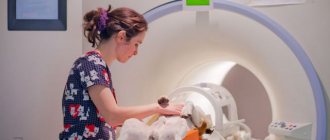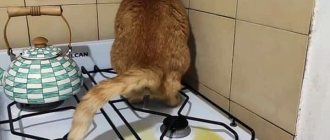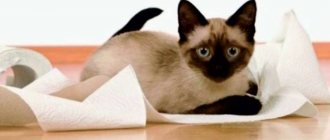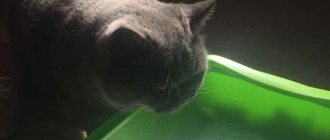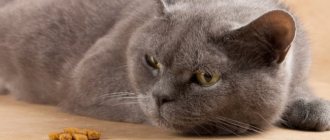Unfortunately, there are often situations when a cat does not go to the toilet in a big way. This causes concern not only for the cat, but also for its owner, since he does not know how to help the pet, what to do in this situation. You should not hope that the problem will be resolved on its own, self-healing will not occur, and the animal will suffer. In this article we will tell you why a cat cannot go to the toilet, and how to help him with this delicate issue.
Why doesn't the kitten go to the toilet?
Let's try to figure out why a little kitten doesn't go to the toilet. There are several reasons why a kitten may not go to bed:
- Firstly, it is stress due to a change in environment. As soon as he finds himself in a new home, he does not go to the litter box for the first 2-3 days. And this is normal, but if there is no stool for about 5 days, then the baby needs help.
- Another reason is the inexperience of the mother cat. As you know, in the first month of a baby’s life, feces are released only thanks to the efforts of the cat. If, due to inexperience or for other reasons, she refuses to massage the kitten’s tummy, then he accordingly cannot go big.
- An early transition to natural nutrition can negatively affect the health of the baby’s digestive system. Ideally, it would be if the kitten switched to full nutrition gradually, while still feeding on the milk of the mother cat.
- Congenital intestinal pathology does not allow the kitten to defecate calmly; in this case, urgent veterinary intervention cannot be avoided.
Causes not related to digestion
Inflammation of the anal glands is another reason for delayed bowel movements. The glands contain an odorous, viscous substance that is released in large quantities every time you go to the toilet. This is how cats mark their territory. When the glands become inflamed, they become blocked and the cat experiences pain. She begins to hold back the urge to have a bowel movement, which can result in constipation.
Inflammation can be recognized by the following signs:
- itching;
- the animal licks the anal area;
- scratches his crotch on the floor.
A preventive measure is cleaning the anal glands using the squeezing method.
In what cases should you consult a veterinarian?
Sometimes in kittens the development of bowel and bladder emptying is accompanied by disturbances. Deviations from the norm can be a symptom of serious problems with the internal organs of a small four-legged pet. You can recognize them in time by:
- constant monitoring of the baby’s behavior during defecation and urination;
- assessing the consistency, color and odor of urine and excrement;
- analysis of the frequency of bladder and bowel movements.
Why doesn't an adult animal go to the toilet in a big way?
To help their pet, the owner must know what factors lead to the fact that the cat does not go to the toilet in a big way. The most common reasons leading to problems with bowel movements:
- Improperly balanced diet. When a cat eats food with a low protein and fiber content, he experiences stool retention, which is also observed when he abuses bones and drinks a small amount of liquid.
- A long-haired cat does not go to the toilet due to the presence of hair in the gastrointestinal tract, which enters the pet's stomach in considerable quantities as a result of the desire for cleanliness. Simply put, hairs that get inside are connected in the form of lumps and create great obstacles both for bowel movements and for the formation of feces.
- Stressful situations can arise not only in a kitten that has just been weaned from its mother cat, but also in an adult animal as a result of an encounter with a dog, a trip on public transport, or the arrival of noisy guests with small children.
- In old age, deterioration of the gastrointestinal tract occurs. The intestines cannot work in the same mode and do a poor job of pushing feces through their departments.
- Neutered cats tend to be obese, they are lazier, prefer to lie down more and are hungry all the time. These factors lead to obesity, which negatively affects the process of bowel movements.
- Diseases of the internal organs can make it difficult to pass stool.
What to do?
Sometimes diseases whose symptom is constipation can be accompanied by other diseases.
Treatment of a disease whose symptom is constipation can only be prescribed by a doctor. Carrying out examinations on your own at home is problematic and not always effective. But you shouldn’t panic because your pet is unwell either.
What should the owner do first:
Analyze the cat’s nutrition and behavior over the last 2-3 days. Constipation may have been caused by overeating or eating unwanted foods. Feel the stomach. Press lightly
Pay attention to the animal’s reaction: does palpation cause pain. Give more water, stop feeding. If constipation occurs after surgery, go to the hospital without delay.
After analysis and determination of the severity of the symptom, it is prohibited to give any medications. Only a veterinarian can make a final diagnosis, as well as prescribe additional examinations (x-rays, ultrasound examinations, urine tests).
Helping adult cats
Adults may be prescribed enemas with the addition of oil and take laxatives. Directions, purposes, and the name of the drug are prescribed by the veterinarian. Unauthorized use is dangerous for the health and life of the cat and can provoke a worsening of the condition.
Help kittens
If a problem stool is detected in a kitten, its diet, quality of drink and food are analyzed.
If a problem stool is detected in a kitten, its diet is analyzed
The maximum assistance that the owner can provide during a pre-medical examination:
- light massage;
- starvation diet;
- drinking plenty of fluids.
If the kitten’s condition worsens or stool does not normalize, urgently seek help from a veterinary clinic.
Enema appointment
Significant results are achieved by using an enema. The method is simple, but it is better not to use it without some practice. The first time is done by a veterinarian.
How to give an enema to a cat with constipation
For the procedure you will need a syringe without a needle and Vaseline oil, chamomile, water. Chamomile decoction can be replaced with saline solution.
How to perform an enema:
- Prepare chamomile decoction or saline solution at the rate of 1 tsp. chamomile or salt per 1 glass of water.
- Give cats a small amount of Vaseline oil 1-1.5 hours before the enema.
- Lubricate the tip of the syringe (the place where the needle is connected) with Vaseline and sunflower oil. Gently insert into the anus. If you have a syringe, the insertion depth should not exceed 1.5-2 cm.
- Pinch the anus with your tail. Keep the animal in your arms in this state for a quarter of an hour.
What to do at home if your cat is constipated?
Significant results are achieved by using an enema.
Douching as a method gives a positive result. But cats don’t like it, as they experience pain during the enema.
Also, frequent use of a syringe as an aid has the opposite effect: the intestines stop functioning normally, and in 75% of cases the procedure provokes the appearance of ulcers.
It is strictly forbidden to use douching if:
- pregnant cat;
- the animal suffers from cardiovascular diseases;
- blood clots and bleeding were noticed;
- there are violations of the integrity of the skin in the genital area.
Changing your diet
A sudden change from one diet to another can lead to digestive upset in a kitten - this can be expressed either by diarrhea or constipation. Therefore, in the first week after purchase, it is advisable to feed the pet in the same way as the breeder did. Good breeders usually pay a lot of attention to this issue and often give new owners a supply of food for several days. Often, owners try to feed the kitten home-cooked food, but it all ends with the kitten eating only boiled or even raw meat and boiled eggs, and such a diet not only does not meet the nutritional needs of the kitten’s growing body, but also leads to constipation.
How can you solve a pet’s delicate problem at home?
When a cat cannot go to bed, she needs to consult a veterinarian, but if it is impossible to organize a trip to the clinic, then you can try using home remedies:
- First, you need to pay attention to what your pet eats. You need to include vegetables, kefir, and milk in your diet.
- You can add 5 drops of Vaseline oil to your cat's food. It is completely harmless to health and has a softening effect. Vaseline oil should not be replaced with vegetable oil, as the latter has a negative effect on the pet’s liver.
- As a last resort, you can give the cat a laxative, for example, Duphalac, Lactusan.
- Sometimes you can relieve your cat's condition with an enema. Doing an enema at home is not recommended. Frequent use of these measures is also prohibited, as they can lead to weakening of the intestinal muscles and the formation of chronic constipation.
- Experienced cat breeders recommend that if the cat does not walk for several days, include condensed milk in the food, dissolved in running water, in a ratio of 3 parts water to 3 parts condensed milk. You need to drink 1 tablespoon per hour. You should not give it more than 5 times a day, as the high sugar content has a detrimental effect on the pet’s body. Condensed milk dissolved in water will loosen the tummy and make bowel movements easier.
- A small kitten can be helped by massaging the tummy, which is performed by gently moving it around the clock cage with a cotton pad dipped in warm water.
- Preparations that help normalize the intestinal microflora, for example, bifidumbacterin or lactobacterin, are good for eliminating problems with stool.
Diagnostics
If the problem is long-term and treatment at home does not work, you need to contact a veterinarian. Usually, an examination and interview with the owner is enough to diagnose the animal.
If a foreign body is suspected, improper bone healing after a fracture, tumor, narrowing of the intestine, protrusion of the rectal wall, a manual examination of the rectum is performed.
In case of frequently recurring cases of constipation, laboratory tests are carried out to exclude diseases of internal organs and systems.
Prescribed:
- Clinical analysis of blood and urine.
- Study of thyroid function.
- X-ray of the abdominal cavity (to detect tumors, foreign bodies, fractures).
- If a tumor is suspected, ultrasound of the abdominal cavity and biopsy.
Possible problems with urination and defecation in kittens
A small kitten must be properly cared for so that it can develop and grow normally. If he is separated from his mother and finds himself in the house of a new owner, then the adaptation period may be accompanied by stress. A number of negative factors can affect the weakening of an animal’s immunity. This affects the functioning of all body systems. Absence or problems with urination and bowel movements during this period are quite acceptable.
When the kitten has grown up and settled down, has become the owner of an excellent appetite, but does not go to the toilet properly, it is worth wondering if everything is okay with him.
Constipation in a kitten
The following disorders can cause constipation in kittens:
- Stressful state. Stress can be triggered by a variety of factors. For example, a visit to the veterinarian, the presence of other animals in the house. However, the most common is a change of residence. The kitten may not have a bowel movement for two to three days. Then everything returns to normal.
- The cat was separated too early. During this period, when the kitten misses its mother's closeness, the absence of stool may last for 4–5 days. If after this period the situation does not change, then you should seek help from a specialist.
- Wrong diet. If the baby ate natural food before he got to his new home, then you cannot suddenly switch him to dry food. Constipation in a kitten can be caused by too much protein in the diet.
- Worms. Intestinal parasites can cause intestinal blockages. This is a dangerous condition that requires medical attention.
If your baby cannot have a bowel movement for more than five days, he needs help. There are a number of recommendations:
- Microclyster. The procedure is allowed if there are no contraindications, that is, if constipation was caused by an unbalanced diet, and not by a violation of the digestive system.
- Enzyme preparations. Prebiotics can be given to a kitten only after prior consultation with a specialist. Mild laxatives prescribed by a veterinarian may also help (medicines for humans are not suitable).
Enzyme preparations must be prescribed by a veterinarian
- Oils. You can add a few drops of oil to your baby's food. Vaseline is the best option, since it cannot be absorbed into the gastrointestinal tract and does not overload the animal’s liver.
I recently learned about Vaseline oil for cats, but have already tried it. You only need a little bit of it, it’s completely unnoticeable with the kitten’s food. But it helps him go to the toilet, like a mild laxative. But others are not recommended to replace it. The same olive oil is absorbed into the gastrointestinal tract and adversely affects the liver.
Sometimes, as a proven old-fashioned method, it is recommended to use baby soap (a small piece is inserted into the kitten’s anus to irritate the walls of the rectum), but it is still recommended to choose more humane ways to help the pet (the same condensed milk will help less painfully).
Frequent stool
When a kitten suffers from diarrhea, this is a sign of a serious malnutrition problem. This situation will require urgent measures and treatment. The entire course of therapy must be carried out under the supervision of a veterinarian.
The most common reason is a change in diet. If the kitten does not receive its usual food, diarrhea occurs. It is necessary to return to your previous diet as quickly as possible.
Changing a kitten’s diet should not be abrupt; it is carried out according to a certain scheme.
There are other reasons for frequent bowel movements in kittens:
- Binge eating. Food that comes in large volumes cannot be digested normally and enters the intestines in liquid form. It is important to control kittens' portions according to their age.
- The food is not suitable or bad. You cannot feed your kitten pickled, fried, salted, or expired foods. This food is not suitable not only for kittens, but also for adult cats. It is not absorbed and causes diarrhea. Also, cats are not given food from the owner’s table (primarily because it contains salt, sugar or spices); food for animals must be prepared separately.
- Allergies or intolerances. Often kittens cannot digest or assimilate fatty fish, beef, and corn. It happens that some elements cause an allergic reaction.
- Poisoning. This phenomenon can be caused not only by food, but also by various substances. A kitten, due to its curiosity, can fit anywhere. Therefore, household chemicals and other chemical elements should be stored out of reach. If the baby is poisoned, then vomiting and lethargy will be added to the diarrhea. Only a specialist can help here.
- Parasites. The first and obvious sign of a kitten being infected with worms is diarrhea with mucus. Only medications can help here. If the case is advanced, then the help of a veterinarian is needed.
- Diseases. The cause of diarrhea can be infectious lesions in the body of a small pet.
Determining the causes of diarrhea
To get rid of the problem of frequent bowel movements, you need to find out its cause. To do this, you need to conduct a stool analysis. Factors of color, consistency, and impurities play a role here:
- Stool with a yellow tint will indicate that the kitten has been poisoned by some kind of food.
- If the feces have an admixture of blood or mucus, then this speaks in favor of helminthic infestation.
- Brown diarrhea indicates an allergic reaction.
- If the stool has a green tint and a persistent unpleasant odor, then the kitten has been poisoned by chemicals.
How to help a kitten with diarrhea
If loose stools have become a one-time occurrence, and the kitten feels normal, that is, he is alert and does not have a fever, then you can simply give the baby plenty of water and put him on a diet. The food restriction should continue for several days until everything returns to normal. In addition, you can give your pet a quarter of a tablet of activated carbon. If diarrhea is prolonged, accompanied by a deterioration in general condition, then an urgent visit to a doctor is necessary. He will be able to diagnose the cause and prescribe treatment.
Video: kitten has diarrhea - what to do
Urination in kittens: normal and abnormalities
In order to determine how often a kitten pees, you need to track how often it drinks water. The amount of fluid you drink should correspond to the amount of urine. An older kitten will empty its bladder up to 5 times a day. The process does not cause discomfort to the baby. Urine should be clean and transparent without any admixtures of blood or mucus.
No urination
If a kitten pees little or does not pee at all, there may be a number of reasons for this:
- suffered stress;
- diseases of the urinary tract;
- kidney disease;
- small amount of fluid consumed;
- exhaustion.
Also, the kitten may not visit the litter box if it is dirty, he does not like the litter, etc.
Many cats are very picky about the cleanliness of the litter box and the contents in it.
If the baby does not pee for a long time, and the owner notices weakness and apathy, lack of appetite, irritability, then you should urgently contact a veterinarian to establish a diagnosis and begin timely treatment.
No matter how many cats and kittens appeared in my house, during the first 24 hours no one peed or pooped. When entering a new home, any animal experiences stress. We understand that he will feel good here, no one will offend him. The cat is not sure about this yet. Therefore, she has no time to relieve herself. She should investigate everything and calm down.
Frequent urination
One of the reasons for frequent urination is the common cold. It can occur due to a draft or lying on a cold surface for a long time. A cold provokes the occurrence of cystitis - inflammation of the mucous membrane of the bladder, as a result of which its contractility is impaired. Cats, like humans, experience frequent urges to urinate, but the amount of urine may be small. the pet also experiences pain when urinating, which can be manifested by meowing.
Frequent urination can also result from:
- impaired metabolism;
- insufficient protein content in the diet.
You should not miss the moment when the kitten becomes a teenager and begins puberty. At this time, he may begin to mark his territory, so he pees more often.
Video: Frequent urination in cats
Rare urination
If the kitten pees rarely or does not pee at all, then this may indicate:
- congenital injury or congenital defect of the urinary system;
- atony of the bladder (weak contractility);
- injury or rupture of the bladder;
- spinal cord injury;
- development of tumors in the genitourinary system.
Anuria (absence of urination for more than a day) leads to dehydration, which can cause death in a kitten. Therefore, any suspicion of urinary problems should be a reason to consult a veterinarian.
Typically, diseases are accompanied by additional symptoms that are difficult to miss.
Lack of urine due to moving to a new place is quite acceptable, but the animal requires monitoring. If you do not urinate for more than 1.5 days, consult your doctor.
List of medications for treating diarrhea
We have prepared for you a rating of the most popular medications and tablets for diarrhea in kittens.
| Activated carbon | The use of this drug is justified only if the kitten simply has diarrhea without additional alarming symptoms. If the pet, despite loose stools, is cheerful and playful, then it is quite possible that with charcoal as a medicine, everything will end and soon the baby’s stool will return to normal. |
| Smecta | The drug has proven itself well in the market of products that promote stool consolidation. You can trust the health of your little pet with Smecta for kittens. And the only thing that needs to be fully understood is the dosage of the drug. |
| Loperamide | Loperamide for kittens is not the best option. Yes, the Internet is full of advice on this topic, but it should be borne in mind that this is still a human drug and even for adult cats the dosage must be selected with special care. What can we say about the fragile body of a defenseless kitten? Therefore, if possible, it is better to treat the baby with something else. |
| Enterosgel | This human drug has taken its rightful place in the first aid kits of cat lovers, since in some cases it is truly an indispensable first aid remedy for a pet. Enterosgel for kittens will help cleanse the baby's body of toxins. Kittens can be given it when:
Enterosgel for kittens is an excellent opportunity to help your baby from the very beginning of the disease. |
| Antibiotics | All antibacterial drugs are divided into classes. This includes both drugs that inhibit the development of bacteria and bactericidal antibiotics for kittens. The most popular medicines include:
Looking from the outside at the mass of these obscure names, it is easy to understand that only a qualified veterinarian can understand this. |
| Enterofuril | The only contraindication for use is age - up to a month, as well as individual intolerance to any active components of Enterofuril, which can provoke an allergic reaction to use. In other cases, this powerful antimicrobial drug will help deal with diarrhea in a kitten in a fairly short time. Moreover, for babies it is better to buy a suspension, since it has a more moderate effect on the weak body of a small kitten. |
Dietary recommendations for a constipated cat
In the question of what to do when a pet does not walk for several days, a therapeutic diet can help, which includes the following diet:
- Soups, cereals, soaked dry food.
- It is best to mix boiled vegetables with the animal’s food, because it is rare for a cat to eat vegetables separately. Zucchini, beets, and pumpkin are good for these purposes.
- Fermented milk products help normalize the digestion process and combat stool problems.
- Raw liver or fish are rarely recommended for your pet.
You should not give a cat suffering from stool retention chicken, chicken broth, rice, eggs, or boiled meat. If a cat eats these foods, he often experiences defecation problems. For cats that do not go to the toilet for several days, specialized food is recommended, which is best selected from a veterinarian.
When a kitten does not go to the toilet for more than 6 days, it is better to find out from the previous owners what the baby eats and give him this food. After 3-4 days, you can gradually add new ingredients, for example, finely chopped meat, it contains proteins and can help solve the problem of feces.
What to do if there are deviations
Violation of the frequency of toilet visits by a small kitten is usually associated with stressful situations. Such factors disappear by themselves when the animal goes through an adaptation period. The situation is more complicated when urination is impaired due to health problems. In this case, the kitten can either walk too often or too rarely.
If a kitten pees frequently, then most likely he has developed cystitis, a disease of the urinary organs, or urolithiasis. The baby will often run up to the tray, but the volume of urine will be catastrophically small. Sometimes there is blood in the urine.
Frequent urges can be caused by drinking too much in hot weather, as well as diabetes. Urinary incontinence is accompanied by a large amount of fluid released and no bleeding. The same signs are characteristic of marking territory.
Cystitis most often occurs in adult kittens. The reasons may be:
- drafts;
- sand in the kidneys;
- impaired metabolism;
- mineral imbalance;
- sexual infections;
- predominance of dry food, lack of liquid and proteins.
Deviations from the norm should be studied and treated in veterinary clinics.
Urolithiasis can affect cats at any age. Signs of the disease are:
- unsuccessful visit to the tray;
- a tiny amount of urine;
- presence of blood in the urine;
- vomiting and high fever;
- lethargy and apathy.
There are cat breeds that are genetically predisposed to this disease. Among them are Scottish Fold, Persian and Siamese breeds.
Also, frequent urination can be associated with diabetes, stress or enuresis. In any case, assistance to the pet must be qualified and timely. If there is the slightest sign of a pathological condition, you should immediately contact a veterinarian. He will prescribe a number of diagnostic measures and adequate treatment.
A kitten who pees frequently will undergo the following tests:
- blood biochemistry;
- Analysis of urine;
- X-ray;
- comparison of the amount of urine and drink;
- Ultrasound;
- hormone test;
- determination of acetone levels and acid-base balance.
These types of studies will help to identify the nature of the disease of the genitourinary system, make a diagnosis and decide on treatment.
In addition to adequate therapy, it is important to carry out a number of preventive measures for the full functioning of the genitourinary system. Regular medical examinations, proper diet, physical activity, and the optimal amount of drinking will ensure normal urination and healthy urinary tract of the kitten.
Rare urination is just as dangerous to a kitten's health as frequent urination. In such situations, the main cause is pathological processes, both in the genitourinary system and in the body as a whole. Almost 75% of cases of insufficient urine flow or insufficient discharge occur due to cystitis. Lack of proper treatment will invariably lead to a condition such as acute urinary retention.
Having such a diagnosis, a kitten may not walk for more than a day. This is a dangerous phenomenon that often ends in death. The bladder becomes full and bursts. Urine enters the abdominal cavity, which can lead to intoxication of the body and death of the pet.
Kittens need to be fed crushed food.
The pathology most often occurs in male kittens. For females, such a disease is not typical, although it is also sometimes detected. The main cause of the disease is stones that block the urinary tract. Experts identify other factors:
- blockage of the urethra by a blood or mucus clot. Occurs against the background of trauma to the genital organ or an infectious disease, in particular the bladder;
- abnormal kidney function. With renal dysfunction, the kitten’s body can no longer excrete urine even in minimal volumes. The cause may be a malignant tumor or perforation of the kidney;
- spinal injury or infectious disease affecting the spinal cord. The absence of a nervous connection between the genitourinary organs and the spinal cord leads to disruption of their functioning and the cessation of urination of the animal.
Urinary retention of any stage requires urgent treatment. In the clinic, a kitten may be prescribed the following procedures:
- catheterization using a special catheter that is inserted into the urethra. This will help empty your bladder;
- surgical intervention. Prescribed in case of ineffectiveness of repeated catheterization.
We suggest you familiarize yourself with: Rules for caring for a Maine Coon, features of keeping: how to feed a Maine Coon so that it grows big
To prevent advanced cases of impaired urination, the owner of kittens must take preventive measures daily:
- animals must receive anti-infective vaccinations on a schedule;
- avoid hypothermia;
- provide access to an unlimited amount of fresh and clean water;
- the diet must comply with the kitten’s nutritional rules according to its age;
- an active lifestyle and outdoor games will also be beneficial.
For any pathological conditions or deviations from the norm, it is prohibited to prescribe medications yourself. Kittens must be treated by a veterinarian. He will also tell you how many times a kitten should poop and pee per day. This will keep your little pet healthy and alive.
Deviation from the norm in the number of visits to the tray requires mandatory consultation with a veterinarian. It is important to quickly determine the cause of the problem in order to prescribe treatment.
Be sure to read:
Causes and treatment of constipation in cats, how to help a cat go to the toilet in a big way
A number of diseases can be successfully treated at the beginning of their development, but in an advanced form they can most likely lead to the death of the pet.
Photo
When keeping pets, you often have to deal with the pathology of such a process as urination.
Noticing that the cat cannot pee, what should the owner do in such a situation? There can be several reasons for disruption of natural intercourse: from banal sexual overstimulation of a male to serious kidney diseases. The first thing to do in this situation is to immediately provide the animal with qualified assistance. Symptoms of difficulty urinating in a pet are quite characteristic, especially if we are talking about a domestic cat:
the animal often stays in the tray for a long time, but there is no urine or a small amount is excreted;
an admixture of blood is detected in the tray;
when visiting the litter box, the cat gets worried and meows;
attempts to urinate may be outside the toilet;
the animal’s appetite decreases or disappears altogether;
When palpating the groin area, tension in the abdominal wall is felt, and the animal experiences discomfort or pain.
It is more difficult to notice similar signs in cats visiting the street or living in a private home. If your pet exhibits symptoms of urinary problems, you should immediately take him to a veterinarian. There may be several reasons for the development of such a pathological condition of the urinary system.
| Causes | Characteristics of the problem |
| Increased sexual excitability in males | The most harmless cause of disruption of normal urination in cats. Due to the overflow of blood in the genital organs, the urethra becomes narrowed or completely blocked, which makes it difficult for the normal passage of urine. This condition is often observed in hyperactive sexual males. The phenomenon is not pathological in nature, but requires mandatory clinical examination to exclude other causes. |
| A common disease among cats associated with inflammatory processes in the bladder. Most often, a hemorrhagic form of cystitis is diagnosed, accompanied by rupture of blood vessels in the mucous membrane of the bladder, which causes the detection of blood in the urine. Often the inflammatory process is complicated by a bacterial or viral infection. A complex form of the disease is idiopathic cystitis. This is a pathology of the urinary tract that is not associated with urolithiasis or urinary tract infection. | |
| Urolithiasis (urolithiasis) | According to statistics, about 12% of domestic cats suffer from the disease; the pathology is especially dangerous for cats. The disease is associated with a metabolic disorder in which salt deposits (stones) form in the kidneys. Moving along the urinary tract, pathological formations injure the mucous membrane, causing pain and pain when urinating. Urolithiasis is dangerous due to complete blockage of the ureters, which leads to painful shock and intoxication in the animal. Failure to provide assistance in the coming hours may result in the death of the pet. |
| Urethritis | It can be primary (genital infections, castration, mechanical damage during catheterization) or secondary (as a consequence of cystitis, pyelonephritis). The disease is accompanied by inflammation of the genitourinary canal, which leads to severe pain when urinating. In droplets, pus. |
| The cause of temporary disturbances in urination may be surgical intervention on the genitourinary organs. Bladder motility is impaired and normal urine separation becomes difficult. |
Diagnosis of the causes of pathology of urination is complex. A urine test is informative, suggesting an inflammatory process, urolithiasis. A diagnostic examination of the kidneys and bladder using ultrasound can reveal the presence of salt formations in the organs and establish urolithiasis in a pet.
Prevention of lack of stool in cats
To prevent cats from having defecation retention, preventive measures must be taken. Firstly, you need to review the animal’s diet and pay attention to what the pet eats during the day. You should not feed your pet from the table. A cat who eats food of excellent quality does not suffer from stool retention. When the owner gives him natural food, he needs to create a diet that contains meat and vegetables. If a cat eats steamed bran, it has a good effect on the functioning of the digestive system.
Cats are fairly clean creatures who always willingly take care of their fur. To prevent your cat from swallowing it, you need to do regular brushing. Pet stores also have products that help remove hairballs from the gastrointestinal tract.
As a rule, neutered cats tend to have a recumbent lifestyle. The less the pet moves during the day, the worse it goes to the toilet. When an animal is given balls, toys, climbing machines, and taken for a walk, then, as a rule, he does not have problems with peristalsis.
Prevention
The best way to control the problem is prevention. Simple rules help reduce the risk of relapse:
- Regular combing of hair should be a mandatory procedure for caring for your cat.
- After treatment, nutritional adjustments are made with increased fluid intake. The pet needs to be fed foods with fiber and added vitamins and minerals.
- If possible, transfer from dry to wet food.
- Do not expose the animal to stress.
- A cat's life should be active. The cat is forced to move and play more.
- Give your pet a paste with cleansing phytomins.
- In the postoperative period, introduce probiotics into food.
Diarrhea in a cat, causes
Diarrhea in cats develops quite often. A one-time loose stool should not frighten the owner, since it is usually a failure that occurs due to minor reasons that do not require a visit to a specialist.
Diarrhea in cats develops quite often
Diarrhea for 2 days or more requires therapy.
There are several main causes of diarrhea in cats:
- Feed intolerance. The animal’s body may not accept the food offered, even when it is of high quality. Most often, the phenomenon is observed when giving low-grade ready-made feed and milk. The problem can be solved by adjusting the diet.
- Sudden change in diet. The cat's intestines and stomach must gradually adapt to the new diet. If it is changed abruptly, diarrhea will easily occur due to irritation of the mucous membrane.
- Worm infestation. The toxins released by worms lead to poisoning, causing loose stools.
- Metabolic disease. This affects most processes in the animal's body, including the number of bowel movements and the density of feces.
- Bowel disease. Diarrhea most often develops with infectious lesions, but may also indicate tumor neoplasms and various ulcerative pathologies. A blood test will be required for diagnosis.
A veterinarian can determine the exact cause of diarrhea in a cat after an examination.
Constipation in cats develops somewhat less frequently than diarrhea.
The following reasons can provoke this phenomenon:
- incorrect feeding system with excess protein;
- dehydration, when stool becomes too hard and cannot pass out of the intestines;
- lack of movement leading to digestive disorders;
- intestinal obstruction (constipation is not the only symptom);
- the presence of hair in the intestines;
- severe stress (leads to constipation and diarrhea equally);
- hernias;
- tumors of a malignant or benign nature.
Giving an animal a laxative until the cause of the disorder is determined is unacceptable. The veterinarian will determine how to properly solve the problem.
Danger of constipation
Constipation in cats can recur after treatment, and in 15% of cases they cannot be cured. The owner must be aware of the possible consequences:
- dysbacteriosis;
- constant intoxication;
- pain;
- metabolic disorders, especially vitamins B12, biotin, folic acid;
- the most serious consequence is colorectal cancer.
With chronic constipation, a cat may not go to the litter box, as it associates it with pain.
How often should a cat go to the toilet?
Ideally, an adult animal should go to the toilet at least once every 2 days. When a cat eats dry food, it visits the tray 1 to 3 times a day. Older animals, over 9 years old, go to the litter tray every other day. A pet that eats food containing fiber and protein can defecate up to 3 times a day. How long a barbel should normally go to the litter tray depends on its nutrition. However, when a cat does not go to the toilet for longer than 4 days, you need to visit a veterinarian.
In conclusion, we can say that you should not rely on chance. If a cat’s defecation delay is not an isolated phenomenon, then it is necessary to consult a specialist who will give recommendations on the choice of medication, determine the cause that caused this condition, and tell the owner what to do to alleviate the animal’s condition.
We recommend reading: What to do if your cat is constipated at home?
Treatment of constipation
Treatment for constipation in a cat depends on the causes of constipation. The main goal of therapy is to soften stool and remove it from the intestines.
If this is an isolated case, and it happened for the first time, then medications are not prescribed. If cases of defecation retention are frequent, the following methods are used:
- Water enema at the rate of 5-10 ml of water per 1 kg of animal weight. Enema with physiological saline solution with the same calculation of proportions. Enema with Vaseline oil for a cat. You can do an enema with Duphalac.
- Abdominal massage.
- Taking oral laxatives for cats.
- Medicines that promote the movement of feces through the colon (Bisacodyl suppositories or glycerin suppositories for children). Suppositories are used alone or together with oral laxatives.
- Increased physical activity.
- Changing the feeding diet: introducing coarse wheat bran and canned pumpkin into the feed.
- Switching to food for cats with digestive disorders. Many brands have such lines, for example, Hill's ID, Royal Canin Fiber Response, etc.
Mild degree
When constipation occurs for the first time, a diet with a high fiber content (psyllium bran, wheat, cereals) is prescribed. Bran is added to the food - 1-2 tablespoons per serving of food.
Before introducing fiber into the diet, give the cat plenty of water to enhance the effect and prevent the accumulation of fiber in the intestines. Typically, most cats benefit from dietary fiber to help cope with the problem.
If constipation occurs again in a cat, Vaseline oil (pure or mixed with milk) or a laxative based on cisapride is recommended: Peristil, Coordinax - 0.1-0.5 mg per 1 kg of body weight.
Average degree
In case of frequent relapses, it is recommended to treat constipation with lactulose-based laxatives: Duphalac, Portalac, Goodluck and increase the fiber content in the diet. The cat is given a laxative every 8 hours at a rate of 0.5 ml per 1 kg of its body weight. The substances in the composition increase the secretion of fluid in the intestines, which facilitates the passage of feces.
If the problem persists, the laxative Bisacodyl and prokinetic drugs Ranitidine or Nizatidine, which stimulate the motility of the digestive organs, are additionally prescribed. However, Bisacodyl should not be used daily. Long-term use of the drug is detrimental to the nerve cells of the intestinal lining.
In difficult cases, hard feces are removed using enemas. Sometimes, if the feces are very dry, the veterinarian will perform a manual bowel cleanse. The cat is given plenty of fluids and anesthetized using an endotracheal tube. Then a saline solution or warm water is introduced into the intestines and the hardened stool is manually kneaded.
If a cat has constipation accompanied by flatulence, then the gases are removed through a probe and then the cat is given Vaseline oil. Pain syndrome is eliminated by Spasmalgon or No-shpa.
If drug treatment does not help, surgery is performed to remove part of the colon.
Elderly cats
Elderly individuals are less mobile, consume less food, which can cause digestive disorders. As a result, the norm is considered to be the appearance of feces in the tray once every two days.
The stool may have a soft or hard consistency. Their color is possible both light and dark. If an older pet feels fine and does not constantly scream due to pain or when going to the toilet, then there is no need to consult a veterinarian.
Be sure to read:
How to train a kitten to use a litter box: step-by-step instructions Video
How can you tell if your kitten is constipated?
Constipation can be expressed not only in the absence of stool. This factor can be missed if the pet has access to the street and defecates there. What are the signs that indicate that a kitten is constipated?
- Frequent but unproductive attempts to go to the toilet.
- The kitten meows when it tries to empty its intestines, walks around the tray for a long time and is afraid of it.
- Dry, hard, small stools.
- Mucus or blood in the stool.
- Lack of appetite.
- The kitten does not lick itself, is lethargic, has lost weight.
- A small amount of liquid feces after the kitten has been pushing for a long time.
Help for newborn kittens
Young kittens often have problems with bowel movements. The fact is that kids need outside help. A cat should lick her babies not only to clean their fur. A gentle massage stimulates the intestines and ensures blood flow. Licking helps the kitten get rid of the contents of the intestines, because he cannot do this on his own.
In the case when a young and inexperienced mother refuses to care for her offspring, a person must help. Help may also be required if the adopted kitten is one month old or less.
In order to perform a massage, you need to take a small piece of soft cloth or cotton wool and moisten it with warm water. Now make short longitudinal movements from chest to tail across the entire tummy. Movements should be very soft, gentle, not causing discomfort to the kitten. There is no need to press on the tummy, just stroke it.


